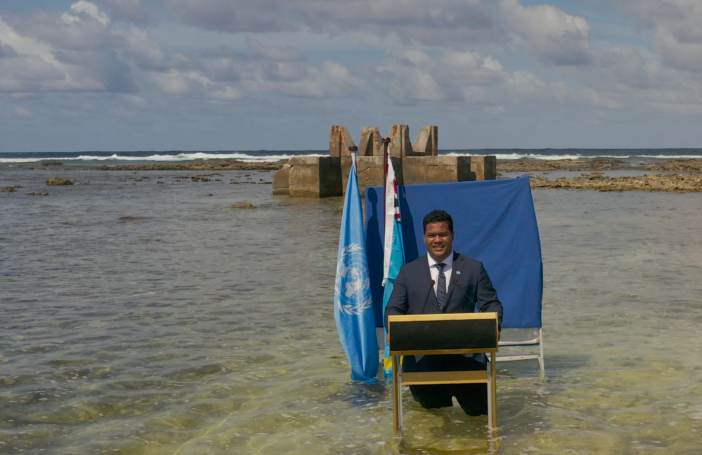It was a big fortnight in migration policymaking this month, with three major inter-governmental events occurring around the globe, in Kiribati (High Level Dialogue on Climate Induced Migration for the Coalition of Atoll Nations on Climate Change), Geneva (the Nansen Initiative’s Global Consultation on the Protection Agenda), and Istanbul (Eighth Meeting of the Global Forum on Migration and Development). Have they brought us any closer to effectively dealing with the critical issue of how climate change will impact on migration?
On the thin strip of land that is South Tarawa, home to over 50,000 people, the signs of climate change are everywhere. During a regular high tide, waves lap at the very edge of the newly constructed road, and occasionally spill onto the narrow causeway that separates the islands. During king tides and storm surges, these same waves pummel seawalls, inundate houses and contaminate groundwater.
This was the setting for the High Level Dialogue on Climate Induced Migration in Kiribati, which brought together representatives from Tuvalu, Tokelau and Kiribati (who are members of the Coalition of Atoll Nations on Climate Change (CANCC)) to discuss the impacts of climate change on migration. Other guests included Prince Albert II of Monaco; representatives of UN agencies, including the Assistant Secretary General of the UN; the Roving Ambassador for Pacific Island Countries and Special Envoy from Fiji; the European Union; the Special Envoy from Tokelau; and members of international NGOs including Greenpeace and Oxfam.
The long-term threat of mass relocation from atoll countries is a hot topic in popular media, but can sometimes obscure the fact that climate change is already impacting on people’s need for migration options. While it is hard to untangle the various reasons for migration, a recent household study in Kiribati by ESCAP, UNDP and the ILO showed that 23 per cent of people who had migrated within or outside of Kiribati said that climate change was a reason for the movement, second only to migration for job opportunities (41 per cent). Combine this with the evidence that 3000 applications are received annually under the Pacific Access Category for just 75 places available to i-Kiribati, and that the workready pool for seasonal workers contains over 1,000 names, though just 168 were given the chance to take part in 2014, and a significant problem of unmet migration demand seems to be looming.
Delegates at the High Level Event agreed that even if significantly up-scaled, labour migration will not and should not be the solution for all atoll people threatened by climate change, and stressed the importance of maintaining pressure on world leaders for a legally binding agreement in COP21. But can labour migration form part of the solution?
The connection between well-managed migration and reduction in poverty is now firmly entrenched, and enshrined in Sustainable Development Goal 10 as well as through inter-governmental dialogues such as the Global Forum on Migration and Development. A burgeoning stream of literature now also shows that labour migration can increase resilience to climate change by providing households in vulnerable communities with a diversified source of income (remittance from a member of the household working abroad) as well as decreasing the strain on limited resources through a decreased population.
At the High Level Dialogue delegates acknowledged this, stressing ‘the importance of labour mobility, which provides immediate climate change adaptation benefits and [invited] the scaling up of existing initiatives and seek new and additional partnerships from the international community on urgent affirmative action for labour mobility of our people.’ While Tokelau and the Republic of Marshall Islands already have access to labour markets in New Zealand and the US respectively, increasing labour migration channels is critical for Kiribati and Tuvalu, where only one to five per cent of the population can take part in temporary or permanent labour migration annually. Combine this with an unemployment rate of 31 per cent in Kiribati (even higher amongst the youth) and limited potential for future private sector-led growth and it is clear why the Kiribati government recently established a national labour migration policy to expand existing decent opportunities for labour migration.
It’s not that Kiribati and Tuvalu are excluded from labour migration programs, but that it is extremely difficult to compete with workers from larger Asian countries, whose sophisticated labour administrations can support much greater marketing and promotion activities with employers and governments. Even where i-Kiribati and Tuvaluans have the right qualifications (which is one of the goals of the President of Kiribati’s ‘migration with dignity’ vision), this is commonly not enough to get workers over the bar of immigration schemes.
The Nansen Initiative appears to recognise this challenge, and has suggested as part of its Protection Agenda – a global document on reducing cross-border displacement signed by 110 countries – that countries could consider developing or adapting national policies providing for residency permit quotas or seasonal worker programs that prioritise people from countries or areas facing natural hazard or climate change impacts, as well as increased training and education.
Currently, only one migration pilot gives prioritised access to people of Kiribati and Tuvalu – this is the recently announced ‘microstates visa’ for Kiribati, Tuvalu and Nauru, which will grant a maximum of 250 places for temporary migration to Northern Australia. This is a good start in recognising the unique risk of future displacement faced by these three countries (which has not, to our knowledge, been taken into account in other migration negotiations including those under PACER Plus or the Pacific Island Countries Trade Agreement). But much more is needed.
First, the new Australian scheme will be employer-demand driven. With limited capacity for marketing and promotion, labour administrations in Kiribati, Tuvalu and Nauru may struggle to make the employer connections required.
Second, given the spiralling population growth and rapidly worsening environment in Kiribati and Tuvalu, many more migration opportunities will need to be available – both temporary and permanent – to realistically offset the risk of displacement. According to one academic estimate [pdf], the number of people who would need to permanently migrate from Kiribati on an annual basis to reduce the risk of mass displacement and maintain a stable population is in the thousands, not the hundreds.
“There is no time more critical than today to address the existential threat of climate change, especially as we prepare for Paris,” repeated the CANCC delegates at the High Level Dialogue. To avert a migration crisis from countries such as Kiribati and Tuvalu, more collaboration with nations which can, in the short and medium term, accept greater numbers of labour migrants is not only critical, it’s urgent.
Akka Rimon is the Kiribati Secretary for Foreign Affairs. Sophia Kagan is Labour Migration Technical Officer in the International Labour Organization (ILO) Office for Pacific Island Countries.






What rise in sea levels has already occurred and what is predicted for the next 50 or even a 100 years?